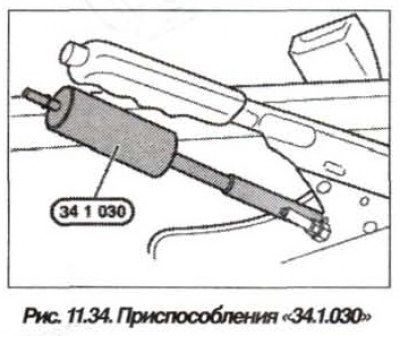Attention! The cable drive and all moving parts of the parking brake system must be easy to move.
The parking brake must be run in before adjustment. On an empty road, at a speed of 40 km / h, pull the parking brake lever towards you until you feel a slight resistance. Move the lever one more click. In this position (with slightly applied parking brake) drive about 400 - 500 m. This will remove the corrosion of the drum and dust from the wear of the friction linings. If necessary, the process can be repeated again, allowing the brakes to cool.
The parking brake is adjusted after:
- replacement of parking brake pads;
- replacement of the brake disc of the rear wheels;
- disassembly of the adjusting device;
- replacement of parking brake cables;
- with a large stroke of the parking brake control lever, more than 10 clicks (teeth);
- if the braking force appears when the lever is tightened one click.
The parking brake must be adjusted in the following order. Prepare fixture «34.1.030» or a screwdriver with a flexible shank for hex interchangeable sockets for adjusting nut and locknut. The rear brake mechanisms of the working system are adjusted.
Raise and put on stands the rear of the car and remove the dust cover of the parking brake lever. Release handbrake lever (set to lower position).
Using fixtures «34.1.030» (pic. 11.34), completely loosen the locknuts and adjusting nuts of the parking brake cables as far as possible. The cables must be completely loose.

Unscrew completely one fixing bolt from each rear wheel and set the wheel with the hole from under the unscrewed bolt strictly vertically down (pic. 11.35). The adjusting nut should be visible through the hole.

Turn with a screwdriver (pic. 11.36) adjusting nut, press the brake shoe against the drum until the wheel stops rotating under the force of the hand - it locks.

Unscrew the adjusting ratchet nut twelve clicks of the latch (teeth). When turning the adjusting ratchet nut, it is necessary to take into account the direction of its rotation. Wheel chock tightening (fit them to the drum) occurs when the rotation of the ratchet nut of the left brake mechanism is carried out in the direction from top to bottom. The tightening of the right wheel pads occurs when the rotation of the ratchet nut of the brake mechanism is carried out in the direction from the bottom up.
Press the brake pedal firmly once and release. Check that the adjusting sleeves of the cables are unscrewed as far as they will go. Tighten and release the parking brake lever five times with a force of 400 N (40 kgf), while the lever release button is pressed. Check the freedom of rotation of the wheels. If there is binding, loosen the ratchet nut.
Adjust brake cables. Raise the handbrake lever two clicks (prong) and tighten the adjusting sleeves of the cables until the braking action appears. Release the brake lever all the way down and check that the wheels turn freely and evenly by hand. Repeat the adjustment if necessary.
Release the parking brake lever all the way down. Turn on the ignition, the parking brake indicator should not light.
Tighten the brake lever one click. In this case, the rear wheels should not brake, the indicator may light up.
Tighten the brake lever two clicks. At the same time, braking force should be felt and the indicator should light up. If it does not light up, adjust the contacts for turning on the indicator on the parking brake lever by bending them.
Switch off the ignition. Tighten the locknuts while holding the adjusting nuts from turning. Establish a protective cover of the lever of a drive of a lay brake.
Lower the car onto wheels. Install two wheel bolts, tighten them to a torque of 140 Nm (14.0 kgf·m). Install wheel caps, if provided.
The main criterion for the correctness of the adjustment is the uniform tightening of both brake drums in the brake discs of the rear wheels.
